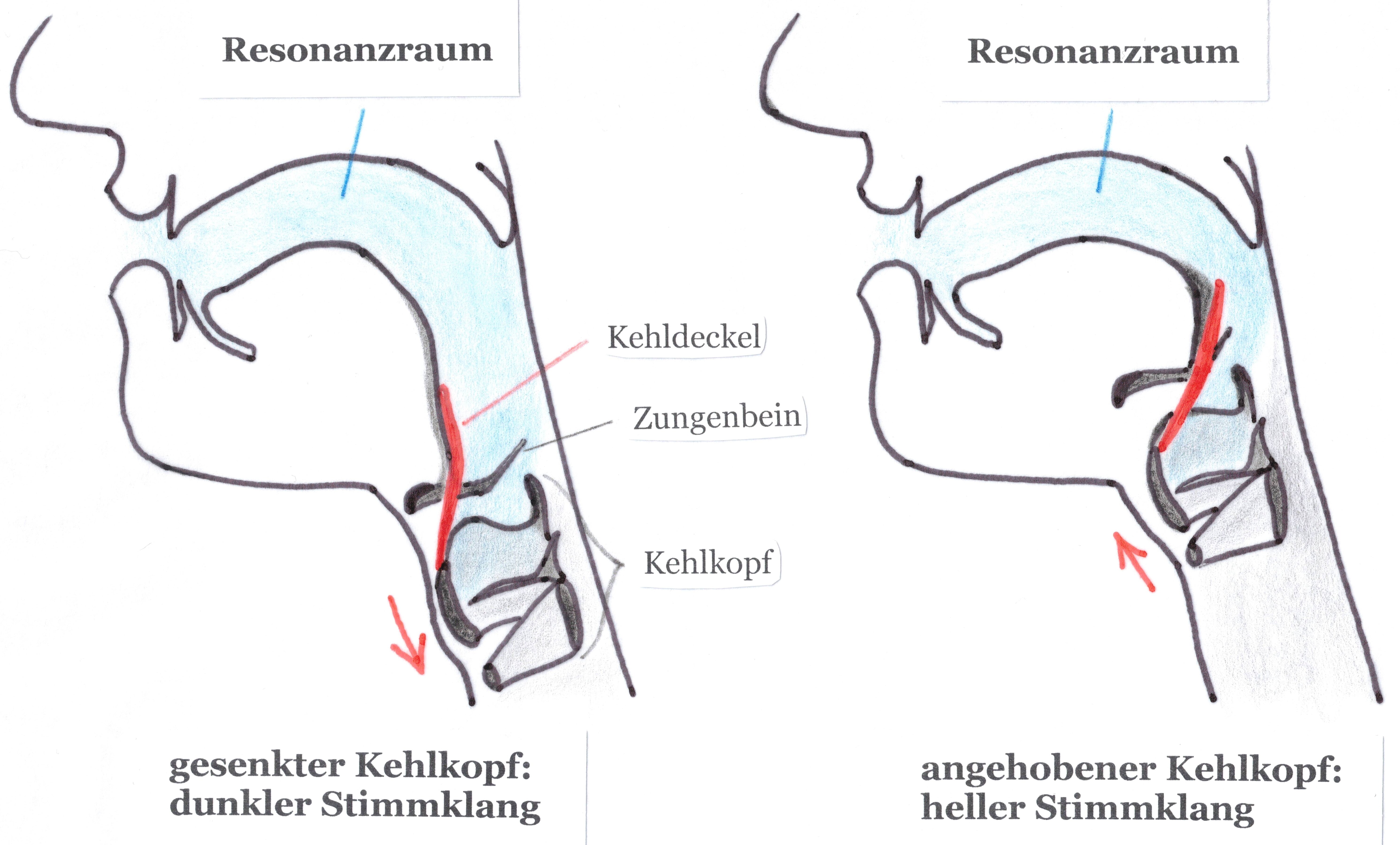One of the earliest discoveries when trying out your voice is how the tone changes depending on whether you raise or lower your larynx. Inexperienced singers often reflexively push the larynx upwards when singing higher notes. When BeltingWhen singing high notes with a full voice, they then realise that their singing sounds unpleasantly tight, shrill or compressed - the warm fullness of sound that they know from their middle voice range is gone.
This is because the resonance chamber that makes the voice sound (the "vocal tract") becomes smaller when the larynx is pushed up.
You can see it here in the picture:

That's why many people ask themselves: Should I try to keep my larynx lower, or even actively lower it, so that the high notes sound fuller and warmer? On the other hand, the darker sound of the notes when singing with a lowered larynx may not match the bright, poppy sound you want to achieve.
In short, every singing beginner realises that the position of the larynx is important for the sound of the voice, but what is the right thing to do: raise or lower - or neither, a neutral position?
Lowering the larynx: Approaching
Let's get the most important thing out of the way first. A slight lowering of the larynx helps against a narrow, shrill tone in the high register. Shakira's song "Whenever Wherever" is an example of this. Here you can hear how she produces a powerful sound in the higher registers, with a darker tone colour, by lowering her larynx:
It is the muscles below the larynx that cause this low position. You use them when you inhale deeply and when you yawn. Try the Yawning exercise:
- Stand in front of a mirror and yawn. You will see and feel how the larynx lowers. This helps you to get a feeling for a lower larynx position.
- When you start singing, make sure that you only maintain the initial position of the yawn - the initial reflex when you breathe in, before you yawn out. The aim is a minimal lowering of the larynx, which ensures that your sound is "yawned".
- It can be helpful to gently place a finger on the larynx after approximating. This allows you to feel where your larynx is when singing and prevents it from rising too high in high passages.
What Shakira only does in her song in certain high passages is an integral part of the singing technique in classical opera. In classical singing, the larynx is held in a relatively low position in order to produce a sound that is as resonant and warm to dark as possible.
In the next example you can see two world-famous opera singers: mezzo-soprano Elìna Garanča and soprano Anna Netrebko with her "Flower Duet". Both emphasise the typically "classical", darker tone colouring of their singing with an oval, downward-pointing mouth position:
In addition to the yawning exercise, a classic among the exercises for deep posture is the Connecting rod exercise. It helps you to bring the larynx down more easily.
- You anchor the tip of the tongue behind the lower incisors, then bring the belly of the tongue outwards with the mouth open, combined with a slight yawning position, and bring the tongue back to its resting position. Repeat this a few more times.
Raising the larynx and twang
In pop music and in genres such as rock or musicals, singers are more flexible with the position of their larynx. Depending on the style, the larynx can sometimes be deliberately raised to produce brighter, sharper sounds or to express strong emotions.
Take a look at a blatant, but no less artistic example of this. Musical singer Bernadette Peters sings and speaks with an assertive twang sound of extreme sharpness:
The muscles above the larynx are activated to raise the larynx. They are part of the swallowing muscles. As with the approximation of the tones to darken the sound, this is also only about the initial impulse, before the swallowing process. If you stand in front of the mirror again, you will see how your larynx rises.
Also on the Twang-sound, the swallowing muscles are involved. They tilt the epiglottis slightly backwards and thus additionally narrow the sound space in the throat. This gives the voice a sharp, bright, typically "twangy" sound.
Flexibility
In popular singing, there is nothing wrong with singing with a raised larynx, especially if you need a brighter sound for your singing. It only becomes wrong if you don't want this sound or if your larynx reflexively pushes so far upwards when singing high passages that it makes your notes shrill or chokes them off. In this case, however, the yawning and connecting rod exercises alone will not help, and good singing lessons are recommended.
Finally, we would like to give you a wonderful exercise that can help you to refine your feeling for the position of your larynx: the "Naa-Eee-Jaa" exercise.
- You glide upwards from a slightly yawned "Naa" to the octave tone and change there to a strongly yawned "Eee". Then you go back to the root note, to a slightly yawned "Jaa". Start in the chest register and increase the yawn as you go up to consciously keep the larynx down.
In this way, you learn to "tame" the larynx so that it does not move upwards unintentionally in the higher register. At the same time, you keep it more open in the high register and thus create more resonance in the throat.
However, you can also experiment with the exercise using a Combination with Twang.
- Incorporate a twangy sound in between, for example by switching from an "Eee" with a twang to an open "Aaa", while pinning the sound. This will give you a feel for the mix and how you can flexibly control the larynx.
Our conclusion on the question of larynx position: there is no simple right or wrong. Whether and how far you raise or lower your larynx when singing depends on the sound you want to achieve (brighter or darker) and the genre you are travelling in. Experiment with the position of your larynx until you find a sound that suits you and that you feel comfortable with. If you are struggling with an uncomfortable tightness in the high register, it is helpful to slightly tighten your notes as described above.
Have fun trying it out and consciously playing with your larynx position!






